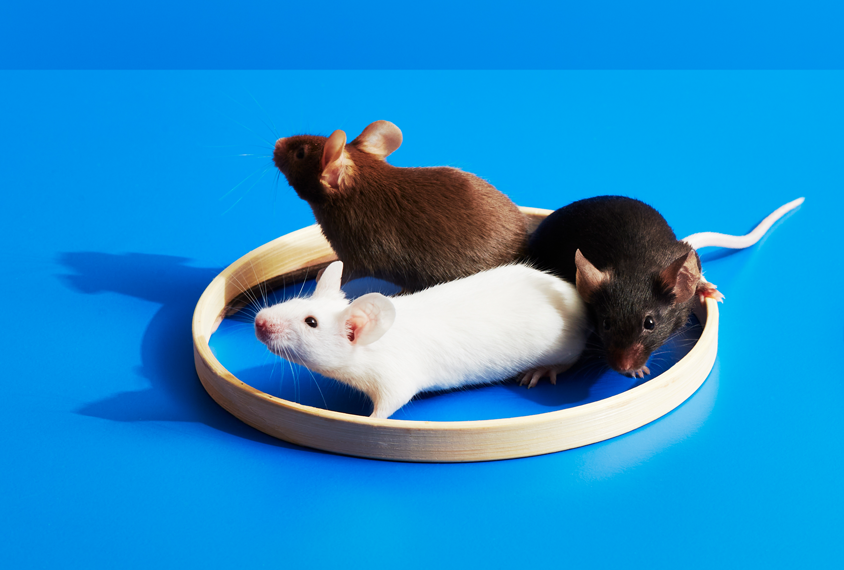An autism-linked mutation in the gene CHD8 yields wildly different physical and behavioral traits in mice depending on their genetic backgrounds, according to a study of 33 mouse strains. The findings were published today in Neuron.
The results serve as a stark reminder that traits associated with an autism-linked mutation reflect more than just that mutation, says senior investigator Pat Levitt, chair of developmental neurogenetics at Children’s Hospital Los Angeles in California. Differences in genetic background could also explain why some findings from autism model mice have failed to replicate across labs, he adds.
People with CHD8 mutations often have autism, intellectual disability, gastrointestinal issues and macrocephaly — larger-than-average head size — but not all of them have all of these traits. This variability may stem from interactions between the mutations and other variants across the genome, says study investigator Manal Tabbaa, a postdoctoral research fellow in Levitt’s lab.
The new work does not reveal how the same CHD8 mutation can affect different mice — or people — differently. But researchers could use the genetically diverse rodents to answer this question, and to better understand and model autism’s heterogeneity, Tabbaa and Levitt say.
“This is such a comprehensive approach to understand a really clinically relevant question, and it’s almost unbelievable that just three people could do this amount of work, considering how much it looks like was done,” says Joseph Gleeson, professor of neurosciences at the University of California, San Diego, who was not involved in the study. “They are just scratching the surface of what could be really fantastic future efforts.”
W
hen scientists model a mutation in mice, they tend to use an inbred strain, such as B6 mice, which are all essentially genetic clones of one another. Using inbred mice minimizes the chance that an animal’s traits are due to random genetic differences.But the choice of mouse strain can influence how a mutation manifests, Levitt says. Researchers almost always use B6 mice, which “are among the least social, so if you’re trying to disrupt sociability, you’re already in the basement,” he adds.
Levitt and his colleagues mated female B6 mice that carry a deletion in one copy of CHD8 with 33 different strains of male mice, including 6 commonly used inbred strains and 27 more diverse ones from the Collaborative Cross (CC) — a collection of interbred inbred and wild strains. All the mice vary in physical traits and demeanors: The so-called CC10 strain, for instance, which the team affectionately referred to as “gentle giants,” has a large body and is docile enough to pet, whereas B6 and CC57 mice are more aggressive, often biting researchers when handled, Tabbaa says.
For each set of pups, Tabbaa and her colleagues tracked the physical traits of eight CHD8 and eight wildtype mice of each sex and put them through five behavioral assays.
Across the entire collection of more than 1,000 mice, CHD8 mice differed significantly from wildtype mice on almost every measure. The CHD8 mice had larger brains, on average, and tended to be more socially dominant when confronting another animal at the center of a narrow tube. Even though the researchers were blinded to the animals’ genotypes during these behavioral tests, the differences between the CHD8 mice and wildtype mice were clear, Tabbaa says, especially in the social dominance test.
But some strains were more susceptible to CHD8-related traits than others, Tabbaa says. Both male and female mice descended from CC2, CC28 and B6 fathers showed significant changes from wildtype mice in seven of the measured traits, whereas those with CC22 and CC40 fathers differed in only two or three.
These differences may model the complexity seen in people, Tabbaa says, in that some people are somewhat resilient to CHD8 mutations, whereas others are more severely affected.
She and her colleagues also saw differences between males and females of the same strain. For instance, the male CHD8 descendants of CC32 mice have larger-than-average brains and do not venture as far as wildtype mice in a test of anxiety-related exploration. Their female counterparts also show altered behavior on that test, but with a smaller effect size, and they don’t have macrocephaly.
“The degree of heterogeneity we saw was particularly surprising,” Tabbaa says. Complex traits are the product of multiple genes, so using just one mouse strain to investigate the effects of a single gene mutation on behavior is like just studying it in one person, Tabbaa says. “For things like behavior, genetic background is everything.”
T
he findings could help explain why CHD8 studies in mice have yielded inconsistent results, says Mark Zylka, professor of cell biology and physiology at the University of North Carolina at Chapel Hill, who was not involved in the study. He has long been concerned that this inconsistency could lead researchers to wrongly reject mouse models of autism genes, he says. “That’s why this is a really important study.”These results also raise a major question, Zylka says: Will each of these mouse strains show the same patterns of sensitivity and resilience to other autism-linked mutations? If not, he says, researchers will need to conduct similar studies on large panels of mouse strains for each major autism gene.
That is exactly what Levitt and Tabbaa say they hope others will do, now that they have put the template out there — but perhaps working as a consortium. “No individual laboratory is going to be as crazy as we are,” Levitt says.
The new results open the door to investigations into exactly how genetic background interacts with high-confidence autism genetic variants. To follow up on this work, Tabbaa is developing an independent research program — as she transitions from postdoc to faculty — to investigate the neurobiology underlying sensitivity and resilience to CHD8 mutations among different mouse strains.






